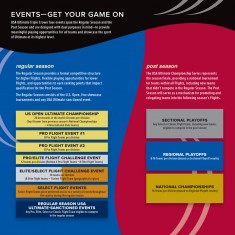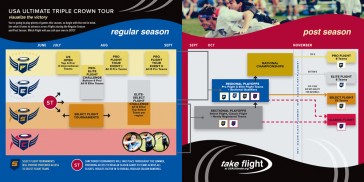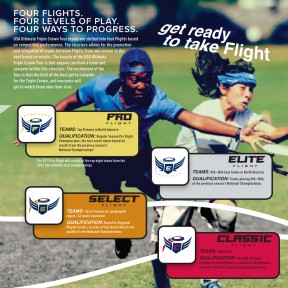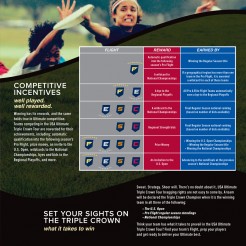USA Ultimate has released the details of a wide-ranging restructuring of the club series that aims to make the sport marketable at the highest levels and more structured, consistent and accessible to players across the country at all levels.
The plan builds off of the current club series in many ways, with the route to the Club Championships still going through regionals. Sixteen teams will qualify for nationals next year. But a four-tier “flight” system and a greater emphasis placed on winning throughout the regular season could see teams in the men’s, women’s and mixed divisions change their approach to the season – and a fan’s experience of the sport.
Front and center is the Triple Crown Tour, which USA Ultimate hopes to brand as a marquee marketing and media focal point for the sport. The tour highlights match-ups between highly ranked teams and their top players – creating easy to follow narratives for fans and media.
Capturing the Triple Crown means winning three different events in one year – the US Open, the regular season and the Club Championships. It is intentionally limited to four teams per division who could potentially win all three, as only national semifinalists are invited to the US Open the following year and winning the regular season is limited to the top “flight” of teams.
The Flights – Pro, Elite, Select, Classic
More pertinent for many more club players is the four-tier flights that will classify teams each season and, according to Will Deaver of USA Ultimate, improve the competition of the regular season.
The highest flight is the Pro Flight, restricted to the top eight finishers at nationals. The next level, limited to the bottom eight teams at nationals, is the Elite Flight. The next 32 teams, based on regular season rankings the year before, will be in the Select Flight. An indefinite number of teams can participate in the Classic Flight.
“This is about creating a deep playing structure at the highest level and ramping it all the way down to the community level,” said Deaver, who as managing director of competition and athlete programs, was a key designer of the final plan. “It is also about having a structure that any community can plug into and have consistent playing opportunities. A player could move to a city and know what to expect – not just an amorphous team that shifts leadership every few years.”
During the regular season, USA Ultimate will host several marquee tournaments that require teams in different flights to attend. The highest flights have the most required events to play. The Pro Flight has three events required, including the top four teams playing in the US Open and the bottom four in a separate crossover tournament with the Elite Flight. The Elite Flight has two events – the crossover with Pro and a crossover with Select. For the Select Flight, these teams get priority into tournaments, including the crossover against the Elite Flight. The level of structure lessens with each Flight, which makes sense since many club teams don’t want to expend a lot on travel. Teams who finish near the top or bottom of Pro, Elite and Select will be subject to promotion up into the next Flight or relegation down into the lower.
To put it in context, there were 260 men’s teams, 230 mixed teams and 115 women’s teams that competed in the series this year. Also, though the gender participation rules won’t change, the “Open Division” will become the “Men’s Division” for marketing purposes.
It remains to be seen what role long-established tournaments like Emerald City Classic, Chesapeake and Labor Day will play in the new format – though teams will still be required to complete a minimum of 10 games next year to try and earn their region an extra bid, so those tournaments will likely have plenty of interest. Deaver said they still want to work with event planners, but also want to see the sport held in venues more open to fans.
The format aims to give second-tier teams the chance to play in bigger tournaments, and provide the truly elite teams with a rigorous schedule and something to chase throughout their season. Initially, cash prizes, supposedly from ticket sales, will be limited to the Pro Flight on the thinking that these players are committing the most resources to play.
But incentives for wildcard bids for the region, a bye past sectionals for both Pro and Elite flights and promotion into a new flight give more club teams a concrete and achievable goal that the current format does not.
The plan seems to thrive on creating events with guaranteed competitive matchups that would matter for players – and fans.
Marketing, marketing, marketing
Growing the number of paying fans who attend a tournament is a big goal of the restructuring, which announced no rules changes but did stress that the location, quality of play and fan interaction were major factors in their featured events.
At all of the “featured” tournaments required of Pro, Elite and Select teams, USA Ultimate envisions creating a fan experience with exciting matchups, interactive skills games for kids and easy-to-follow storylines. For the media, the sport becomes more consistent, with teams likely having to set rosters earlier and play a higher level regular season.
Behind all of these changes, according to USA Ultimate CEO Tom Crawford, is a push on growing the sport and taking it to the next level.
“We really want to drive growth from the grassroots. In talking with other sports, the family fan base and youth base is where the growth comes from,” said Crawford. He also mentioned that a major sports marketing firm and a national television company were both very interested in the new format, citing the guarantee of seeing top talent play. Crawford did not name either company during an interview.
“Many people play sports when they are younger. Even after they stop, they continue to be fans and follow the game,” said Deaver. “Kids are where fans come from. You realize a sport exists and then you see it on a stage.”
What remains to be seen is how the sport’s top talent will disperse among the Triple Crown Tour, AUDL and the newly forming Major League Ultimate – and can that top talent deliver a product attractive to marketers, fans and broadcasters?
Both Crawford and Deaver were emphatic that the Triple Crown Tour, nearly three years in planning, was not affected at all by the formation of outside leagues. And though Deaver said USAU is working closely with the World Flying Disc Federation, there’s no clear plan for how teams could do both Worlds and the Triple Crown.
Deaver was careful to emphasize the plan’s focus on involving everyone in the sport and making competitive ultimate more widespread.
“We have the coolest sport in the world,” said Crawford. “And no one knows about it.” Crawford used himself as an example, citing that he was a huge sports fan who had never heard of ultimate until three and half years ago.
“When I saw it played, I knew this was the best sport on the planet. I want to see this come to life. It’s for everyone. The number one goal of our strategic marketing plan is exposure for the sport,” said Crawford. “I want to get rid of the Tom Crawfords of the world – every sports fan should know ultimate.”
Feature photo by Jeff Bell – Ultiphotos.com










Comments Policy: At Skyd, we value all legitimate contributions to the discussion of ultimate. However, please ensure your input is respectful. Hateful, slanderous, or disrespectful comments will be deleted. For grammatical, factual, and typographic errors, instead of leaving a comment, please e-mail our editors directly at editors [at] skydmagazine.com.